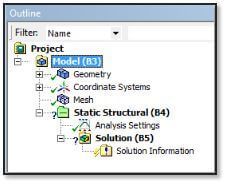

! Adjust temperature result by +459.67 degrees. The macro can be easily changed to add 273.15 so that a Celsius result is converted to a Kelvin result. However, it is up to the user to make a suitable selection of elements and nodes (usually the entire model), and to use the SET command to load the thermal result of interest, before applying the macro below to raise the temperatures at nodes by the amount 459.67. In addition, the result is usually loaded by a SET command that points to the desired load step and substep. The following macro assumes that a temperature result exists in the user’s model. Method | Given Temperature Assumptions in the User’s Model Its action will typically be faster than a SET command that retrieves a result from the RTH results file for a large model. Here, the macro presented uses vectorized commands so that the conversion is quick when dealing with very large FEA models. Additionally, the macro can be easily adapted to work with Celsius/Kelvin.


This article illustrates a small macro that switches a temperature result in degrees Fahrenheit into degrees Rankine by adding 459.67 degrees to the temperature at each selected node. Or, conversely, to convert a result in degrees absolute into the usual scale. Users performing thermal analysis occasionally want to change the plotted temperature result to degrees absolute. Industrial Equipment and Rotating MachineryĪnsys Mechanical APDL | Performing Thermal Analysis Offsetting Temperature Results to Degrees Absolute.Torsional Vibration Measurements Testing.Fluid Flow & Thermal Applications (CFD).Electronic and Electrical Applications (EM).


 0 kommentar(er)
0 kommentar(er)
